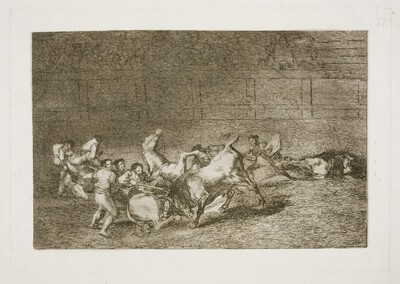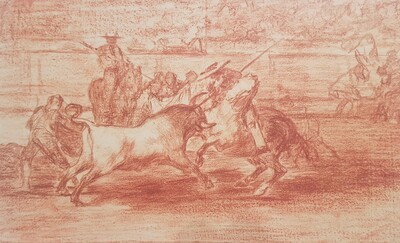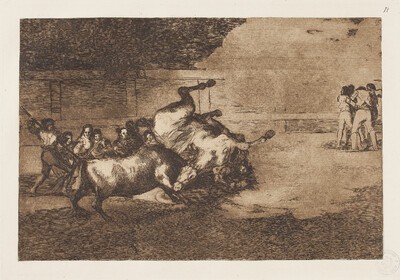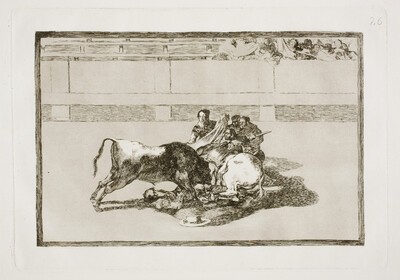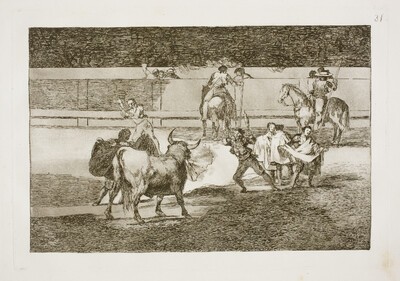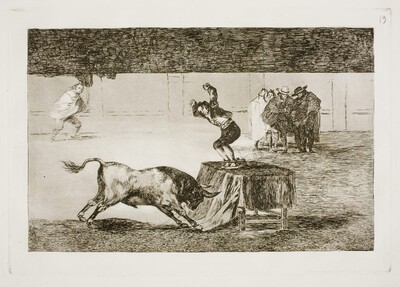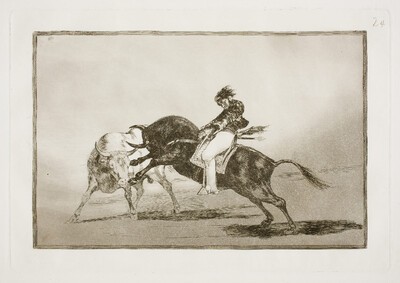- Cronología
- 1814 - 1816
- Dimensiones
- 250 x 352 mm
- Técnica y soporte
- Reconocimiento de la autoría de Goya
- Documented work
- Ficha: realización/revisión
- 01 Oct 2021 / 22 Jun 2023
- Inventario
- -
- Otros títulos:
-
28 ((print, upper right-hand corner)
Goya(print, under right-hand corner)
See How the ancient Spaniards hunted bulls on horseback in the countryside
A state proof of this print, made before Goya engraved the serial number on the plate, is in the Dutuit Collection, Musée du Petit Palais, Paris (Dut. 5393).
The plate is in the National Chalcography (no. 361).
See How the ancient Spaniards hunted bulls on horseback in the countryside
This picture narrates an episode of a mishap in the suerte de varas. In this case we see how the picador, on the back of his horse, is driving the pike into the bull, while the bull has thrown himself at the equine's neck and has one of his horns inside it. In addition, there are a series of peons who, with capes, urge the bull to break away, while another picador observes the scene and waits for the best moment to finish the job. The picador in the foreground, Rendón, whose chest almost touches the other side of the bull, is holding the stick tightly and the rest of the bullfighters are nervously taking the fight. It is a harsh scene of violence and a great deal of movement, which is conveyed not only through the figures in the foreground but also through the secondary figures in the background who jump over the barrier, either to enter the ring or to escape from it. The most outstanding light is in the central part of the scene, which cuts through the mass of spectators in the background, resolved in dark tones.
Glendinning relates the print, which is one of the few signed Bullfighting prints, to others that have characters with somewhat distorted faces, a feature that in his opinion implies a criticism of those who participate in one way or another in a bullfight, such as Martincho's recklessness in the bullring of Zaragoza, Another madness of his in the same bullring, Ceballos himself, mounted on another bull, breaking rejones in the bullring of Madrid, The fall of a picador from his horse under the bull, Fire bull or Two groups of bullfighters run over at once by a single bull.
Martínez-Novillo, for his part, relates the print thematically to the engravings Fall of a picador from his horse under the bull and Two groups of picadors run over at once by a single bull, to which he adds a third, Unfortunate charge of a powerful bull (Bullfighting B). He considers these works to be the culmination of what is captured in the present print. They are all violent and harsh scenes, works of both conceptual and plastic importance that had a notable influence on other artists such as Picasso, who ended up turning the bull into a true obsession.
In Matilla's view, the violence of the print is conceptually close to that of the Disasters of War. He also points out that once again we are dealing with the representation of the public as a mass and recalls that the fact of reflecting the death of two horses in the bullring also occurs in two other prints in the series, specifically in the aforementioned Fall of a picador from his horse under the bull and Two groups of picadors run over at once by a single bull.
There is a preparatory drawing of the present print, also entitled The hard-working Rendón stinging a bull whose fate killed him in the bullring in Madrid.
-
Grabados y dibujos de Goya en la Biblioteca NacionalBiblioteca NacionalMadrid1946catalogue Elena Páez Ríos
-
Goya en la Biblioteca Nacional. Exposición de grabados y dibujos en el sesquicentenario de su muerteBiblioteca NacionalMadrid1978May - June 1978
-
Grabados de Goya: colección propiedad de la Biblioteca Nacional, que se conserva en su Gabinete deCasa de la Amistad de MoscúMoscow1979exhibition displayed from January 18th to 31st 1979
-
Goya. Das Zeitalter der Revolucionen. Kunst um 1800 (1980 – 1981)Hamburger KunsthalleHamburg1980cat. 254
-
1984
-
Madrid1987
-
Goya: toros y torerosEspace Van GoghArles1990displayed also at Academia de Bellas Artes de San Fernando, Madrid, consultant editor Pierre Gassier.cat. 44
-
Goya grabadorFundación Juan MarchMadrid1994consultant editors Alfonso E. Pérez Sánchez and Julián Gállego, from January 14th to March 20th 1994
-
Goya grabadorMuseo del Grabado Español ContemporáneoMarbella1996from March 8th to May 5th 1996
-
Zaragoza1996
-
Schlaf der Vernunft. Original radierungen von Francisco de GoyaMunich2000
-
Madrid2002
-
Madrid2002
-
Bilbao2012
-
Zaragoza2017
-
1946pp. 177-216, espec. pp. 203-204
-
BarcelonaTartessos-F. Oliver Branchfelt1946 (reed. 1951)
-
1961pp. 120-127
-
OxfordBruno Cassirer1964vol. II, 1964, p. 344, cat. 231
-
Vie et ouvre de Francisco de GoyaParísOffice du livre1970p. 279, cat. 1206
-
Goya, Das Zeitalter de Revolutionen. 1789-1830HamburgPrestel-Verlag Münche und Hamburger Kunsthalle1980p. 292
-
MilwakeeMilwaukee Art Museum1986pp. 26 y 32
-
Goya, toros y torerosMadridMinisterio de Cultura, Comunidad de Madrid1990p. 254
-
MadridCaser-Turner1992p. 35
-
Catálogo de las estampas de Goya en la Biblioteca NacionalMadridMinisterio de Educación y Cultura, Biblioteca Nacional1996cat. 353
-
MadridMuseo Nacional del Prado2001pp. 88-89
-
SevillaSociedad Estatal Nuevo Milenio2001pp. 290-291, cat. 76
-
Goya. In the Norton Simon MuseumPasadenaNorton Simon Museum2016pp. 186-201

